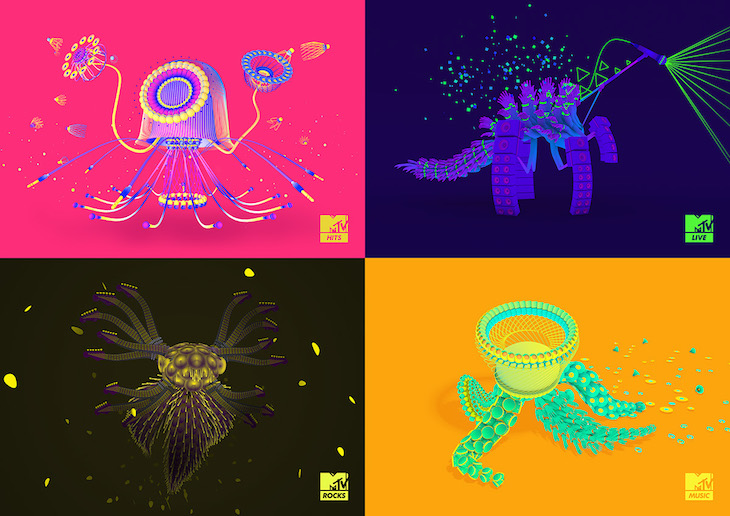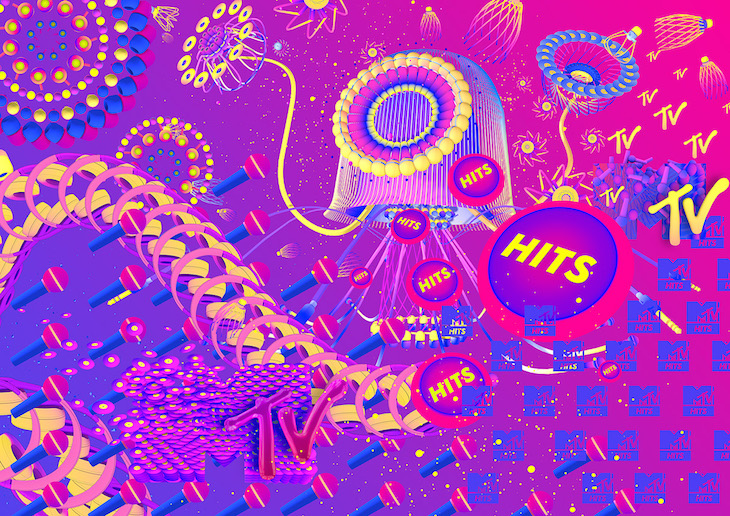We all know a party animal when we see one: They’re the blissfully wild, free-spirited person at the concert or birthday bash or wine tasting or other social occasion who just seems to know how to have a better time than everyone else.
But what might a real party animal look like? Not the staggering human hero getting ready to dive into the mosh pit, but an actual creature whose very DNA is laddered with strains of pure kickin’ it? Where might it live? How might it move?
Now, thanks to MTV International, we know the answers to these burning questions, via a sweeping rebrand of its seven music-themed flanker channels, Live, Hits, Classic, Rocks, Music, Base and Dance, which broadcast in different regions across the globe and complement the MTV flagship channel. In a collaboration between MTV World Creative Studio and animation/design studio Laundry, the seven outlets have been united in the way of lands, each treated as a virtual continent of music and entertainment in its own right, where resides a species of party animal that has evolved within its own unique landscape of sound and color and movement.
“It was a big visual creative puzzle,” said Maximiliano Borrego, Creative Director at MTV World Creative Studio. “We were faced with the challenge of finding a conceptual and visual thread that connected everything. Something unique and identifiable across the channels that would, above all, entertain our audience.”
They also had to “holistically fit within the larger brand ecosystem of the MTV family of channels,” said PJ Richardson, a realm that was revitalized in 2015 with a flagship rebrand that teems with eye-popping hues and Internet-ready graphics. The launch included implementation of a cross-channel template infrastructure referred to internally as Wireframe + Skin, “a skeletal framework that represents a visual guide, created with the purpose of arranging content, elements, navigational systems and how they work together,” Borrego said. “These wireframes are skinned with the look and feel of every channel, by using different colors, logos, backgrounds and container boxes.”
Within those guidelines, it “was wide open in terms of what the graphics look like behind it or how we colorized it, or textures or animations that we put within the letter forms themselves,” Richardson said. The results elegantly shape the MTV identity into a world that feels unto itself, yet built from the same core elements.
“The key,” Borrego said, “was to deconstruct the identity of each channel and translate it into characters that you could relate to. That’s exactly what happened when we met the party animals for the first time; we immediately connected to them.”
“They’re the perfect visual metaphor for the diverse music genres and fans of the world,” added Anthony Liu, partner and executive creative director at Laundry. “Different in their influence and location, but same in their fandom and human spirit.”

Considering the primary pieces of the flanker channels’ united identity as living creatures at an actual party was helpful in establishing a visual tone to represent each channel’s specific music genre, Richardson said, because if you consider the movement of onscreen elements as “a character or a person, they can dance like they’re at that party. They all conceptually took a cue from the music they represent.”
In a weird way, the resulting party animals look like the physical manifestation of the movement one might make to that music. The creation for MTV Live, for instance is a dinosaur-looking creature that “would fully walk and shake its tail at the party,” Richardson said. The creature for MTV Dance resembles an electric eel that shimmies and twists and recalls the light streaks created by glow sticks at a rave. The creature for MTV Base is “somewhere between snail and a scorpion,” Richardson said, crawling with the slow-burning power of a thunderous groove.
“It’s not about making an animal the same color as the channel,” said Borrego. “It’s more about understanding the identity of the channel, what and who it represents, and being true to that with the animals.”

The Wireframe + Skin framework also allows for a library of loopable animated elements called Invaders, which act “almost like little sprites,” Richardson said, and align thematically with the given genre of the channel they appear on. Laundry turned its Invader contributions into something “almost like skin elements that we translated into the party animals themselves,” he added. The Rock channel’s Invaders, for instance, take the form of things like drumsticks and spikes, which in turn help make up the body of the Rock party animal, a snazzy insectile creation with fluttering fronds of antennae that appear to be made up of guitar necks. Meanwhile, a network of speaker Invaders compose the shell of MTV Base’s snail-scorpion party animal, and MTV Live’s strutting prehistoric stomper has a microphone stand for a neck and head, towering legs made up of concert speakers, and a spindly back and tail consisting of waving human hands.
Besides pulling in specific graphical elements from the channel they appear on, the party animals reflect how one might move to the beat of its given outlet’s music. The billowing jellyfish monster concocted for MTV Hits, for instance, “fluidly punctuates and spins and dances, but in a gliding way,” Richardson said, “like big anthem songs” themselves, the channel’s bread and butter. Meanwhile, over on MTV Classic it gets even weirder, with “something between a straw dress and a ram” cavorting around in the land of hit videos and shows from the ‘80s and ‘90s. “Like a the sound of a shaker but with a lamb and a happy, stringy dress thing,” Richardson said.
While the party animals can definitely look a little insane, there was a method to the madness beyond just trying to invent something weird and crazy-cool. “We also came up with them because it gave our animation team instructions on where to work from,” Richardson said, “so it became less of a guessing game of, does it walk or does it do this? You kind of knew how the animals would work based on how they looked. It was a completely functional roadmap in the most odd way imaginable.”
And it’s very true – just a still shot of the MTV Classic party animal, with its dazzlingly frayed posterior and rigid upper half, gives you all you need to understand what it would look like in motion. Indeed, the key art for all the party animals is so expressive, they almost appear to be already moving. It’s the result of letting music and the way one moves to it inform creature design instead of vice-versa, and in its own weird, wonderful way, it feels like a completely new thing in television.

CREDITS
Client: MTV Networks / Buenos Aires, Argentina
Creative VP: Sean Saylor
Creative Director: Maximiliano Borrego
Design Lead: Charx Alemagny
Operations & Production Director: Josefina Marfil
Production Manager: Delfina Chiesa
Design & VFX Company: Laundry / Los Angeles, CA
Creative Directors: PJ Richardson & Anthony Liu
Executive Producer: Dan Masciarelli
Producer: Rebecca Park
Designers: PJ Richardson, Anthony Liu, Brett Albert, Nicole Choi, Eddie Bong, Cynthia Lou, Janice Ahn & Will Goodman
Animators: Brett Albert, Yang Liu, Samantha Liu, Yongmin Park, Kasey Allen, Aziz Dosmetov, Samuel Baese, Andres Barajas, Richard DeForno, Jesse Nelson, Brock Boyts & Jim McDaniels
Rigging: Brett Morris
Editor: Justin Freedman
Assistant Editor: Jonas Dickson
Tags:










































__twocolumncontent.jpg)











